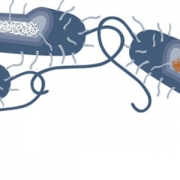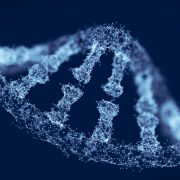Hidden viruses in the human genome
As research reveals ancient viruses lurk in our DNA, can genomics provide the missing link in treatment of modern disease?
The virus is a simple but powerful form of life. With the very smallest and most basic of genomes they can live and reproduce – effectively by slipping into host cells and hijacking their machinery to make new viruses. Some of the very smallest viruses, such as retroviruses, go one further – not just entering the cell but actually inserting their own genome into that of the cell, the better to exert control.
Retrovirus revival
In fact, some of the inactive DNA in any human genome derives from viral DNA. These human endogenous retroviruses (HERVs) are ancient viruses that integrated into an ancestral human genome long ago – sometimes dubbed ‘fossil viruses’. Usually they lose parts of their original sequences over time, due to mutations in the DNA sequences, but some retain whole genes that specify the production of viral proteins. They persist because they were inserted into human reproductive cells (a rare event) and thus passed on to new generations of humans.
Ancient viruses and human disease
We have accumulated quite a few ancient viruses, it seems; estimates vary between about 4 and 8% of the total human genome, but identifying individual HERVs is difficult because most of them are very rare. However, new research examining the genomes from around 2,500 people of varied ethnic origins found a total of nineteen new different HERVs or viral DNA sequences. Most of these were incomplete, but there was one full viral genome sequence among the new HERVs – only the second ever to be identified. Seventeen previously described viral sequences were also found.
The health implications of carrying fossilised viral genomes are not well understood; some experts think they may have had beneficial effects on their human hosts, but others have also linked them with autoimmune conditions and certain cancers. HERVs could also play a role in the origins of complex psychiatric diseases such as schizophrenia and autism spectrum disorder that are thought to arise from combinations of many genetic and environmental (external) factors.
A modern foe: HIV
Although we don’t yet understand enough about how these ancient viruses contribute to human disease, we are well aware of how some of their modern relatives do, such as Human Immunodeficiency Virus (HIV). This is a retrovirus that enters white blood cells, makes DNA copies of its own genome, and inserts them into that of the human host cell. Active infection leads to loss of white blood cells, which in turn makes patients susceptible to other forms of infection. One of the enduring difficulties in attempts to cure patients infected with HIV (as opposed to merely controlling the infection to minimise ill-effects) is the capacity of the virus to lie dormant (latent) in cells and hide from the body’s immune system.
Now researchers have harnessed the new CRISPR genome editing technique to cut the viral genome out of latently infected white blood cells without harming the human genome. They reported that the cells were then free of HIV and protected against fresh viral infection. Virus load in white blood cells after treatment was lower, making gene editing a promising new line of investigation into potential new treatments for HIV infection – and perhaps even a cure.
–









